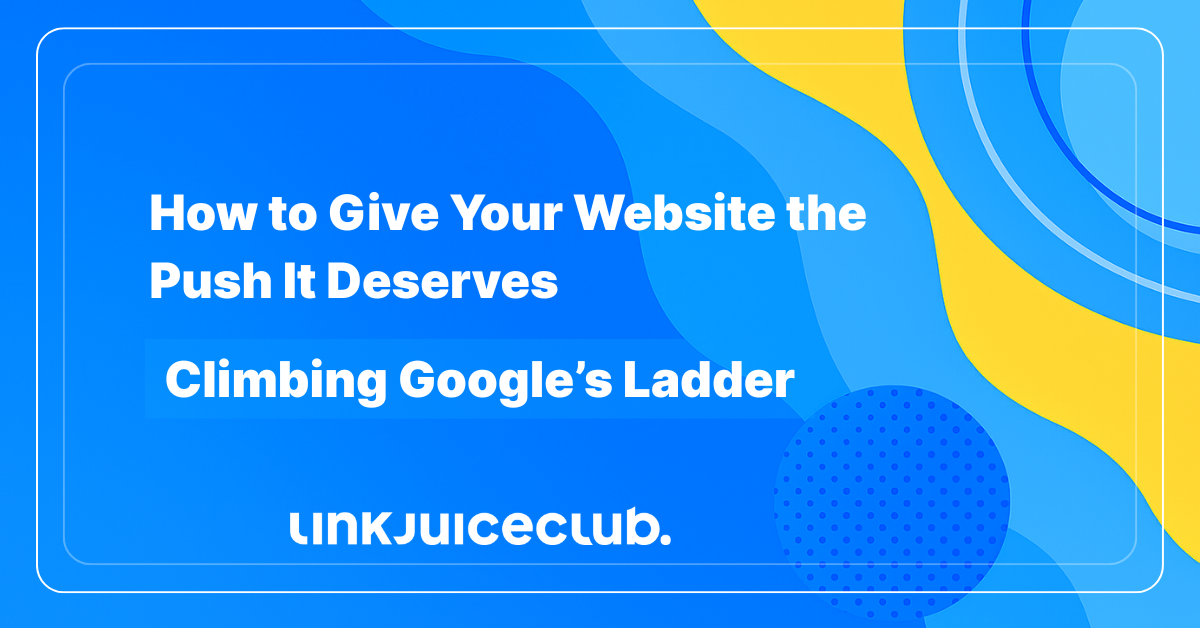
Climbing Google’s Ladder: How to Give Your Website the Push It Deserves
Let’s not beat around the bush. Getting your website to rank well on Google is a bit like trying to squeeze into your old jeans after Christmas. It can be done, but not without a good dose of strategy, persistence, and to be perfectly frank, a few uncomfortable truths. You cannot simply build a site, scatter a few nice pictures across it, and cross your fingers. Google does not run on wishful thinking. It runs on relevance, credibility, and a healthy dose of algorithmic know-how.
Now, before you start muttering about how things were done in your day, let’s have a proper look at why all of this actually matters and how you can go about doing it properly. No half-baked advice here. This is a full roast dinner of a guide, made to help your site rise where it belongs.

Why Your Google Rank is the Digital Equivalent of a Good Reputation
In the online world, where everyone’s shouting for attention, a top spot on Google is like owning the only pub in a thirsty village. You don’t need to beg people to visit, they should come to you. Why? Because when you’re top of the list, you’re seen as credible, reliable, the real deal.
Ranking well means you’re not buried under your competitors. You’re standing proudly at the front of the queue. People are more likely to click on you, trust you, and do business with you. Whether you’re selling lawnmowers, fixing radiators, or dishing out knitting patterns, if you’re visible, you’re relevant. If you’re invisible, well…you may as well not exist.
And it’s not just vanity. A top spot brings more organic traffic, which means more potential customers without having to fork out on endless ads. That’s free promotion, 24/7. It’s the dream, really, but like all good things, it doesn’t happen by accident.
A Thorough, Gritty Guide to Improving Your Google Ranking
Let’s get into the guts of it, no fluff, no faff. This is everything you need to know to give Google a reason to notice you.
🐢1. Website Performance: No One Likes a Sluggish Site
Think of your website like a front door. If it takes ages to open, people turn around. If it looks like it’s held together with duct tape and stubbornness, they run. Google notices this too. Slow loading times, broken pages, and a design that looks allergic to mobile phones? That’s a one-way ticket to page three, straight into digital Siberia where nobody’s clicking and everyone’s forgotten you exist.
Speed matters. If your site takes more than a couple of seconds to load, visitors bounce, and Google clocks it. Compress your images, trim your scripts, and make sure your hosting isn’t something you picked up second-hand from a bloke in a pub.
And don’t forget mobile. Over half of all searches are done on phones these days. If your site looks like it was made in 2006 and has buttons the size of Smarties, you’re in trouble.
🧹2. No Page Left Behind: Clean Up Those Orphans
Ever find a drawer full of old cables and wonder what any of them do? That’s what orphan pages are like for Google – unconnected bits of content with no links pointing to them. If Google can’t find them, neither can anyone else.
Link your pages properly. Every single page should have a purpose, a direction, and a route in and out. Internal links not only help your visitors navigate, but they help Google map your site, like breadcrumbs through the woods.
✍️3. Content: Write Like You’ve Got Something to Say
Content is the steak and chips of your website. Without it, there’s nothing to chew on. But it’s not about quantity alone. Rambling nonsense or keyword stuffing won’t win you points.
Your content needs to answer questions clearly and helpfully. Write like you’re explaining something down the pub, not presenting a thesis. Use your keywords, but use them naturally. Google has grown up now, it knows when you’re trying to game it.
Keep your spelling and grammar clean, too. You wouldn’t hand someone a business card with your name misspelt on it, would you?
🎬4. Meta Titles and Descriptions: First Impressions Matter
When your website shows up in search results, your meta title and description are the only things standing between a click and a scroll-past. It’s your elevator pitch in about 160 characters.
Your title should be short, sharp, and to the point. Tell people what they’re getting, no riddles. Your meta description should seal the deal, so make it intriguing, relevant, and human.
And for heaven’s sake, don’t leave them blank or let Google fill them in automatically. That’s like showing up to a wedding in your gardening trousers.
🖼️5. Images: Dress Smart and Speak Up
A picture might be worth a thousand words, but to Google, it’s just a silent rectangle unless you give it a voice. Rename your image files to actually reflect what they show. “sprocket-diagram.jpg” beats “IMG_3728” any day.
Then there’s the “alt text” – a bit of info that tells search engines (and screen readers) what the image is. This isn’t just good for SEO, it’s essential for accessibility.
And finally, don’t forget the title tags, the little tooltips that pop up when someone hovers over the image. A small detail, yes, but they all add up.
🔗6. Link Building: The Internet’s Version of a Character Reference
Backlinks are links from other websites to yours, and they’re Google’s way of seeing who trusts you. It’s like having people in the village vouch for your honesty. But not all endorsements are equal. A link from a well-known, reputable site is worth far more than a dozen from a random blog that hasn’t been updated since the Olympics were last in London.
When it comes to earning those links, think quality over quantity. Get your name out there by writing guest articles, joining relevant directories, being active in your industry. And don’t ignore internal links either. Link your own pages together logically. It shows structure and helps search engines crawl more effectively.
One thing though: patience. Link building isn’t a one-week project. It’s a long game, and rushing it with shady shortcuts can backfire in spectacular fashion.
What You Actually Get Out of a High Ranking (Besides a Swollen Ego)
Now let’s talk results. Because if you’re going to put all this effort in, you want to know what you’re getting back.
More Visibility: People can’t click what they can’t see. Being at the top means your site is front and centre when someone searches for what you offer.
Better Quality Traffic: You’re not attracting random passers-by. You’re getting people who are actively searching for what you do. That’s like having customers walk into your shop and already know what they want.
Trust and Authority: Whether we like it or not, people trust Google. If you’re top of the pile, they assume you’re legit. That trust translates into action: calls, emails, purchases.
Long-Term Value: Unlike paid ads, which vanish the moment you stop paying, organic traffic is sustainable. A well-ranked page can keep bringing in visitors for years, like a good investment.
Lower Marketing Costs: With strong SEO, you rely less on expensive advertising and more on the strength of your content and reputation. That means a better return on your time and money.
Brand Awareness: Even if someone doesn’t click the first time, they’ve seen your name. The more you show up, the more familiar you become, and familiarity breeds trust.
This Is Where the Climb Begins
So there it is, a proper set of tools to help you take on the Google rankings with purpose. It might feel like a lot to juggle at first, and fair enough, it is. But you are not expected to master it all in one go. Start with the foundations: tighten up your site, sharpen your content, and get the essentials right. From there, build steadily and deliberately.
Google favours consistency, clarity and genuine usefulness. Its job is to point people to the best option, and your job is to make sure that option is you. Not by being the loudest voice in the room, but by being the most helpful, the most relevant and the most dependable.
It is a marathon, not a sprint. Every step takes you closer to the peak. Before long, you will find yourself not buried beneath the rankings, but standing confidently near the top, where people are actually looking.
Let’s get to it.





